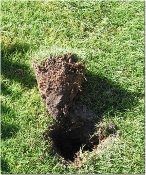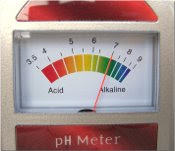And I think all gardeners and growers understand why a soil's water content plays a major role:
- too wet, and it turns into sticky 'plasticine', impossible to control
- too dry, to dust
However, there is a very narrow window of opportunity which presents itself as a soil dries out (thank goodness).
At this point, it forms into a ball when squeezed in the hand. And this ball breaks up easily when poked with a finger. This happens to all soils and composts which contain some structure to bind them (it is that same condition, ideal for propagating cuttings, described earlier). At this stage, the soil is said to be FRIABLE.
THIS IS THE IDEAL CONDITION FOR LAWN AERATION, especially by hand fork.
FABULOUS DRYING DAY
Today's weather came right out of the blue. The cold north-east wind is really drying things up, especially the lawn.
I r
 ushed out with my trowel and removed this divot. Can you see what I mean about thatch? It starts at the top and goes about two thirds down, to a depth of about 5 cm (2 inches).
ushed out with my trowel and removed this divot. Can you see what I mean about thatch? It starts at the top and goes about two thirds down, to a depth of about 5 cm (2 inches).But it's not the thatch we're interested in at this stage; it's the dark soil beneath it. I'm not sure if you can see, but it's still rather wet, but becoming rapidly drier. And because this weather is set to continue tomorrow, this would be a good opportunity for aerating the heavier ground (who knows what the weather might do next; and for how long?).
AERATING WITH A FORK
 The rows are similar to hollow-tining (shown here), but wider apart. However, the process is different.
The rows are similar to hollow-tining (shown here), but wider apart. However, the process is different.Using my fork with the finest (thinnest) tines (a border fork), I drive it full depth into the turf, at a slight angle back from vertical.
On pulling the fork handle back towards me about 30 cm (1 foot), a layer of turf, at least 10 cm (4 inches) thick, is prised up on the tines. When the fork handle is raised and the tines withdrawn, this turf does not fall back completely (since it has been stretched), but remains slightly arched. Since the fork holes are in rows, the effect is to produce something like shallow drills of turf across the lawn, separated by the rows of fork holes.
It is the ARCHING which is important. The fine tines break a friable soil up easily, including any compaction (this technique is especially useful for areas of heavy traffic).
Aeration is achieved, firstly from the holes made by the fork; and secondly by the newly-formed cracks in the turf (caused by stretching).
IDEAL FOR LIQUID AUTUMN FEED
The holes are at the bottom of the ridges. So liquid feed can run straight into the soil, down to the roots. This is important for root formation, since phosphates (essential for root production) are, within a short time, nearly completely immobilised upon entering the soil.
And things get even better: rainwater can also get through the turf.
SPACING
About 25 cm (10 inches) between rows, for a small border fork, seems ideal.
FEEL THEM ROOTS
The idea is to get the fork in deep enough to reach beneath the roots. What I find is that this is easy in the heavier parts, where root formation has been limited by poor aeration. But one can feel the roots really resisting where the conditions for growth have been ideal. At this point, forking is not necessary; pricking will do, just so the water and feed can get through the turf.
LEAVE UNCUT
I really prefer to do this after the last cut, since it is important not to re-compress the turf. However, I find a small hover mower ideal, especially since the grass is best left longer so it has maximum length to produce food to fuel root production. I know it can thin the turf, but it is worth it at this stage.
HIGH POTASH FEED
Do not use summer feed; use a high potassium autumn feed. If you can't get a liquid (tomato feed will do), get a good brand of granules (this might contain a mosskiller and weedkiller).
P.S. Good news, thatch-wise: It's a lot softer than it was - the woody rhizomes have almost broken down (probably thanks to our early summer feeding).


















